 |
 |
|
The partial
eclipse on October 23rd using a Lunt Hydrogen Alpha telescope.
The long filament next to the shadow is over 200,000 miles long.
Photo: J D
Maddy |
Thru eclipse
glasses or a filtered telescope, this is what the eclipse looked
like.
Photo:
Richard Bohner |
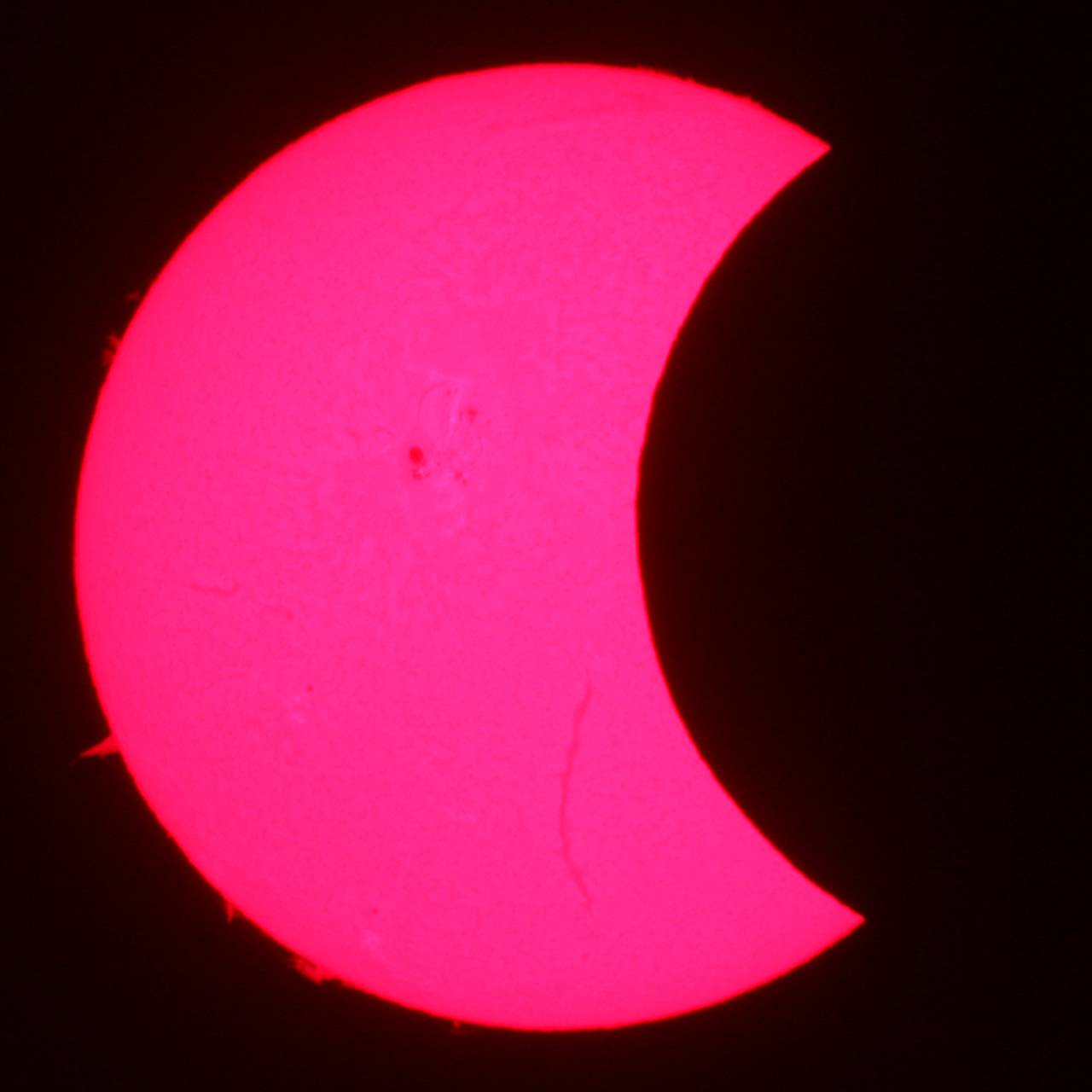 |
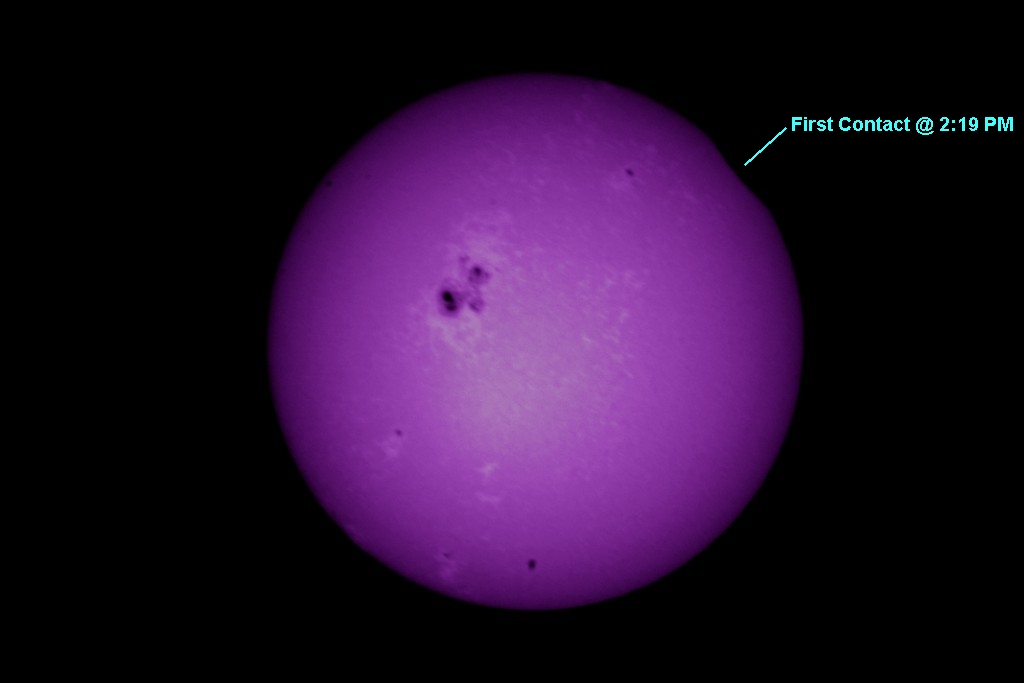 |
|
A look at
the eclipse on October 23rd thru the Club's PST Hydrogen Alpha
telescope. Flares around the Sun could easily be seen.
Photo: J D
Maddy |
First
contact of the Moon's shadow was at 2:19 PM Arizona time as this
CaK UV picture of the Sun shows.
Photo: J D
Maddy |
 |
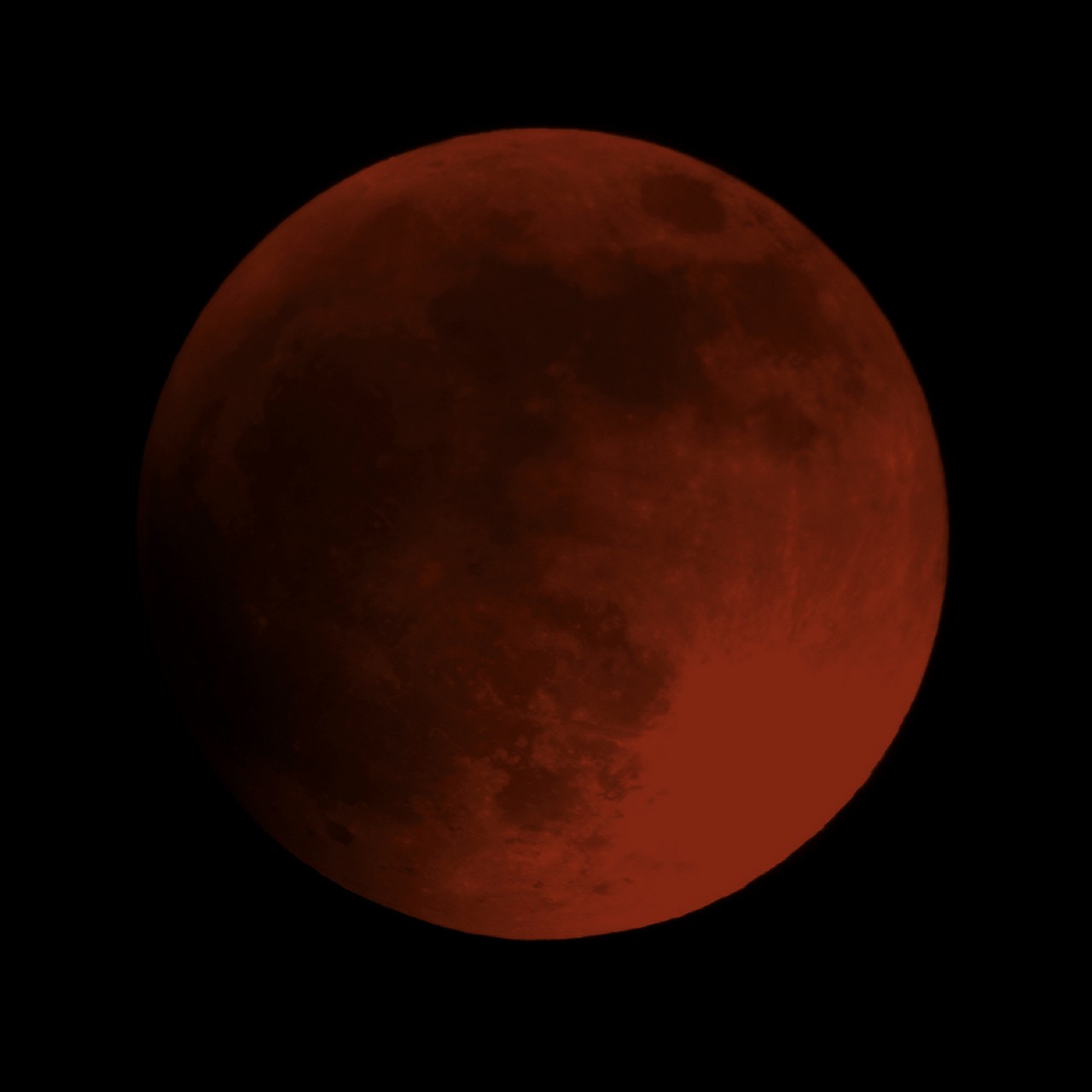 |
|
Totality
lasted over one hour starting at just past midnight local
Arizona time.
Photo: Barry
Middleton |
Even from
the light polluted skies of Phoenix, the eclipse was visible.
Photo: Jan
Weaver |
 |
 |
|
A tripod and
digital camera makes it easy to capture a wide field view of the
eclipse. A red Moon with a nearby red Mars was quite a site.
(Mars is upper right)
Photo:
Richard Bohner |
The
technique used for this picture is normally used for deep space
photos. Separate images taken with Red, Blue and Green filters
are combined to create the color photo.
Photo:
Robert Mueller |
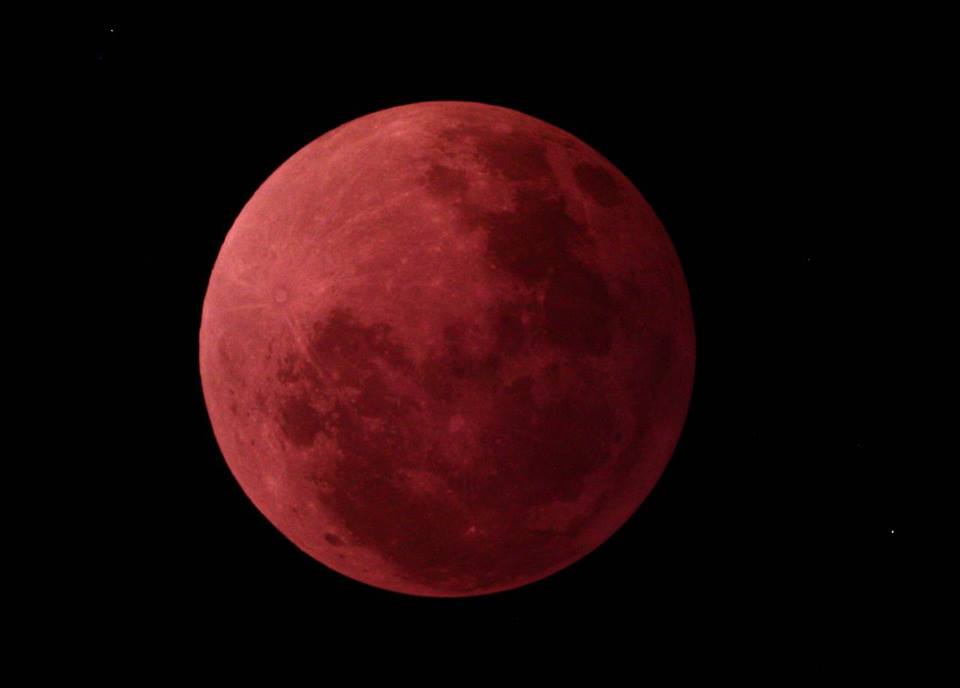 |
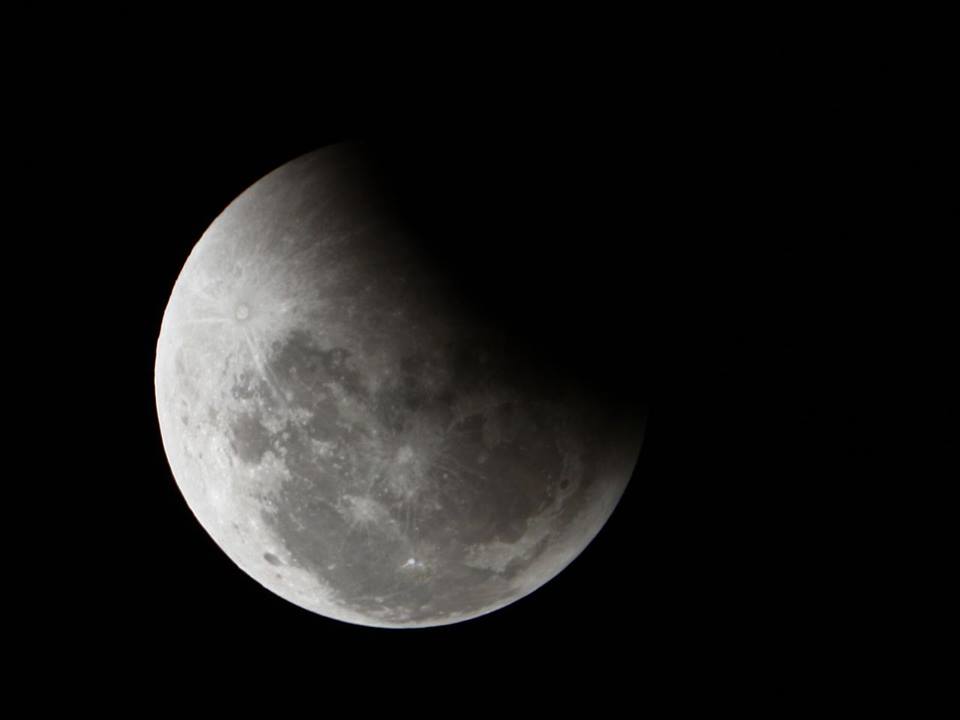 |
|
Totality
just past midnight.
Photo: J
D Maddy |
Nearing
completion of the eclipse event.
Photo: J D
Maddy |

Totality just past midnight.
Photo: Doug
Ostroski |
|
 |
In case you missed the lunar eclipse's in
2014, there are 2 more total lunar eclipses over the next 12
months. This series of lunar eclipses is called a tetrad. The last two of the tetrad will occur
in April and September of 2015. |
 |
 |
|
A
compilation of the eclipse
Photo: Doug
Ostroski |
A
compilation of the eclipse
Photo: J D
Maddy |
 |
 |
|
A
compilation of the eclipse. Mars is upper right.
Photo:
Robert Mueller |
A Lunar
Eclipse occurs when the Moon goes into the Earth's shadow. The
picture above shows the reason behind the coloring of the Moon.
The Earth's atmosphere acts like a prism and causes the Moon to
appear to glow in the yellows and reds.
Illustration:
J D Maddy |
 |
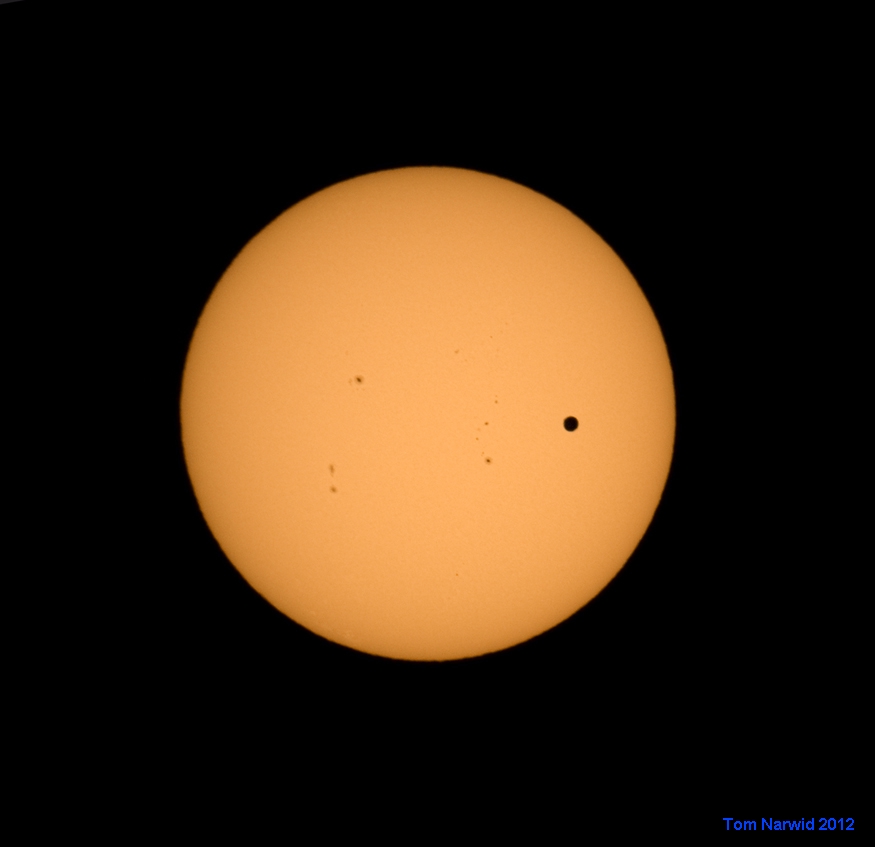 |
|
Second
contact occurs when the trailing edge of Venus touches the outer
edge of the Sun.
Photo: Tom
Narwid |
From Arizona
the transit was only visible for half its journey as the Sun set
before its completion.
Photo: Tom
Narwid |
 |
 |
|
Another
phenomenon that occurs with transits is know as the Tear Drop or
Black Drop Effect. This occurs at second contact and the
intruding planet appears to smear as it enters the disk.
Atmospheric disturbance causes this.
Photo: Doug
Ostroski |
The complete
transit was not visible from Arizona and it is setting over
Mingus Mountain and has first contact with a tree!
Photo: Doug
Ostroski |
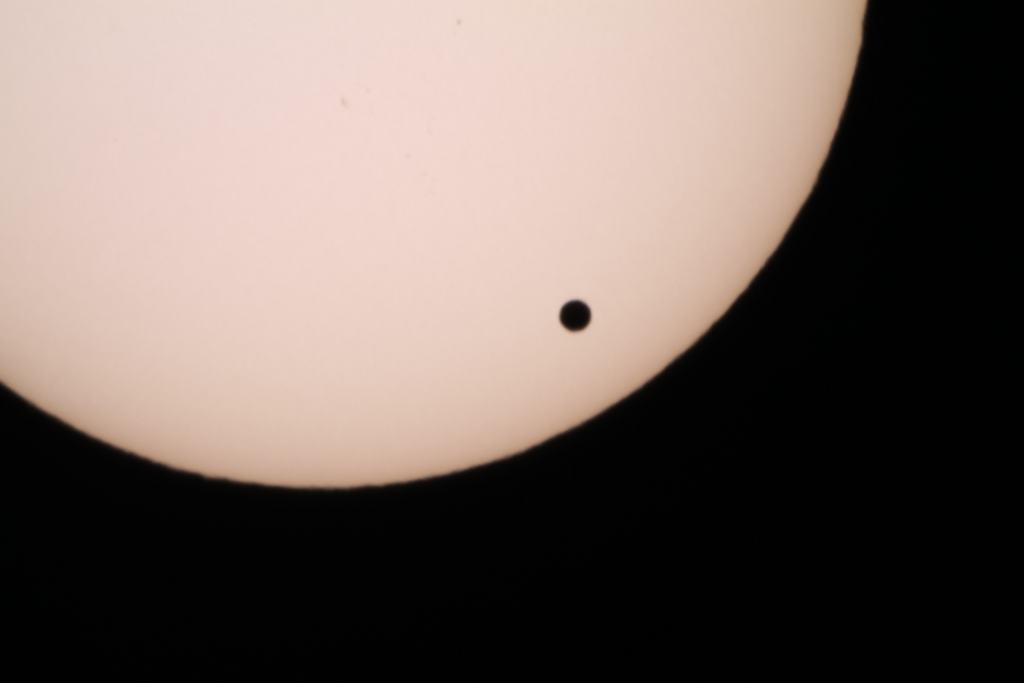 |
 |
|
Using a
glass Orion Solar Filter gives this appearance in the telescope.
This is one of Dave's first attempts at solar imaging.
Photo: Dave
Norton |
Sunspots
above Venus are easily seen as the planet passes by them thru
out the event.
Photo: Dave
Norton |
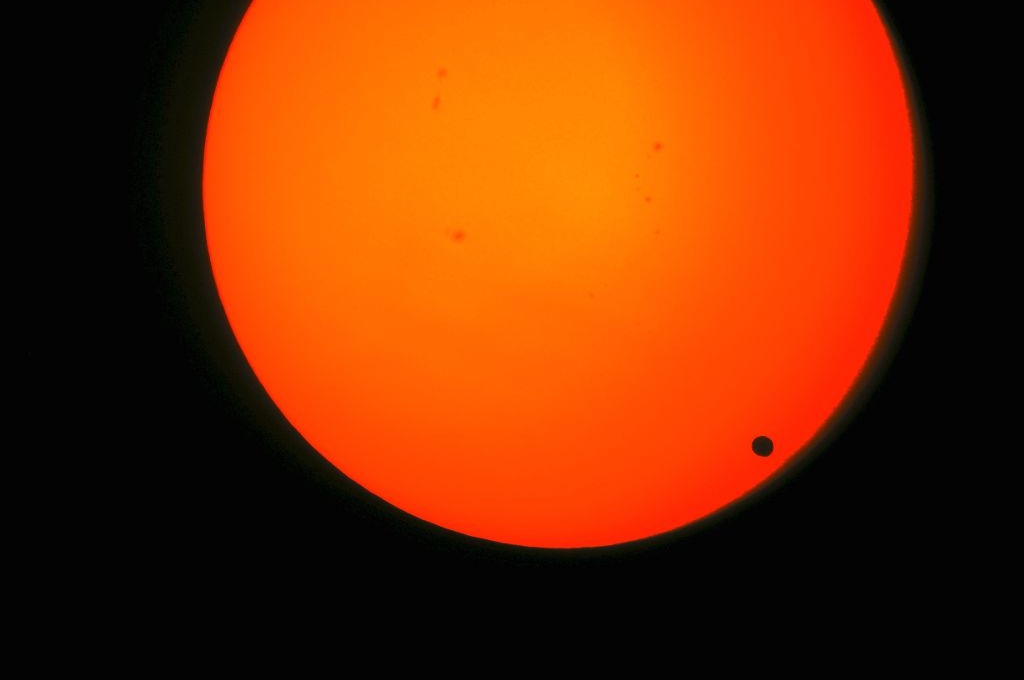 |
 |
|
The nice
thing about some astronomical events is that you can see them
from just about anywhere. And, light pollution doesn't matter
much with the Sun. This picture was taken from Phoenix.
Photo: Jan
Weaver |
In the midst
of all the hoopla with the solar eclipse and the transit, many
forgot that there was a Lunar eclipse on the morning of June
4th.
Photo: Pat
Seals |
 |
 |
|
First
contact is a bit tough as Venus is small in comparison to the
Sun's size.
Photo: J D
Maddy |
Second
contact occurs when the trailing edge of Venus touches the edge
of the Sun.
Photo: J D
Maddy |
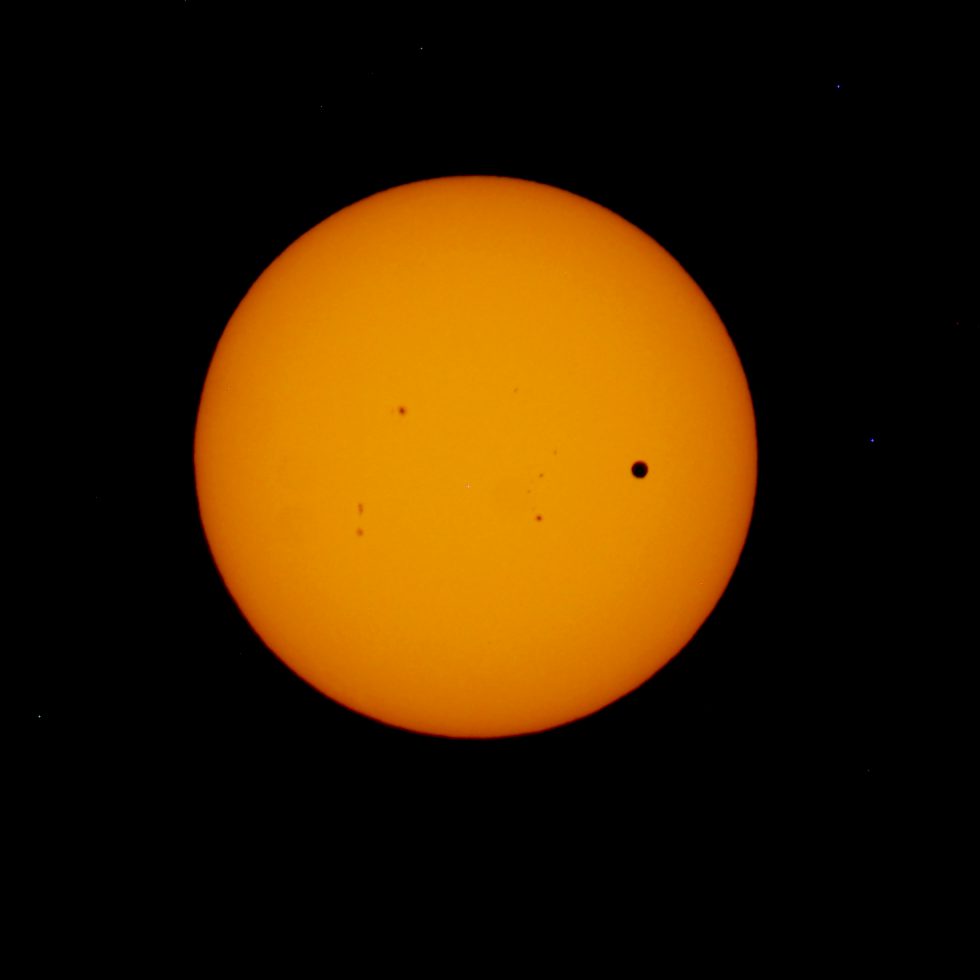 |
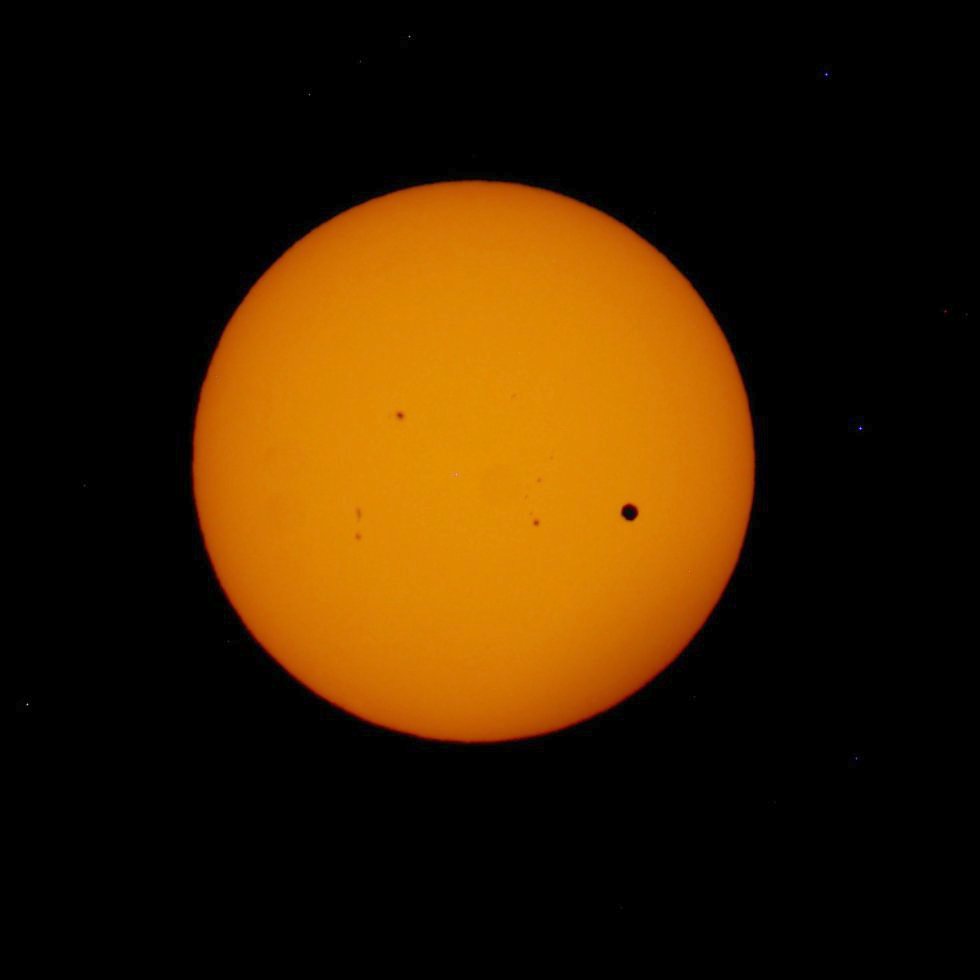 |
|
Mid transit
has Venus showing up visually by using eclipse glasses or #14
welding glass.
Photo: J D
Maddy |
At about
6:45PM, the Sun went down behind Mingus from this location. The
transit was just past being half way done.
Photo: J D
Maddy |
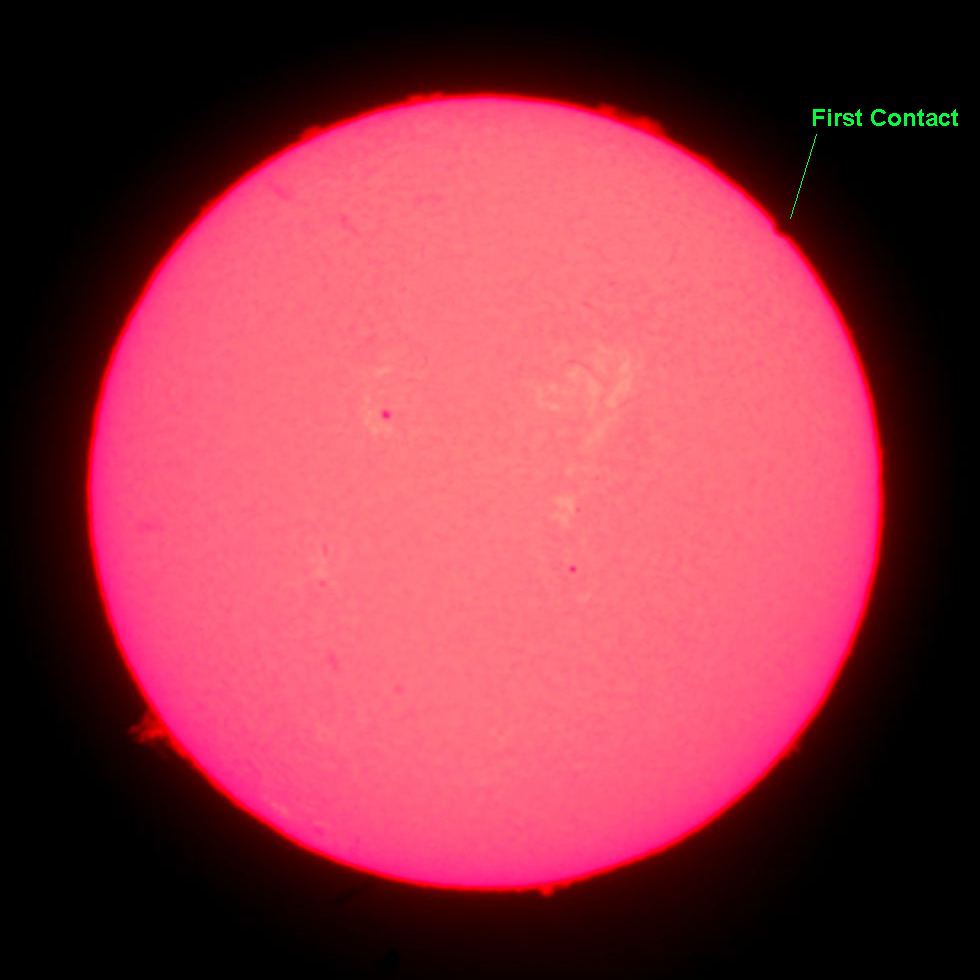 |
 |
|
First
contact with a Lunt Ha telescope. This scope allows the viewer
to see solar flares and prominences along with surface detail.
Photo: J D
Maddy |
The last Ha
picture of the day 3 hours and 33 minutes from first contact
shows the flare activity changing a bit.
Photo: J D
Maddy |
 |
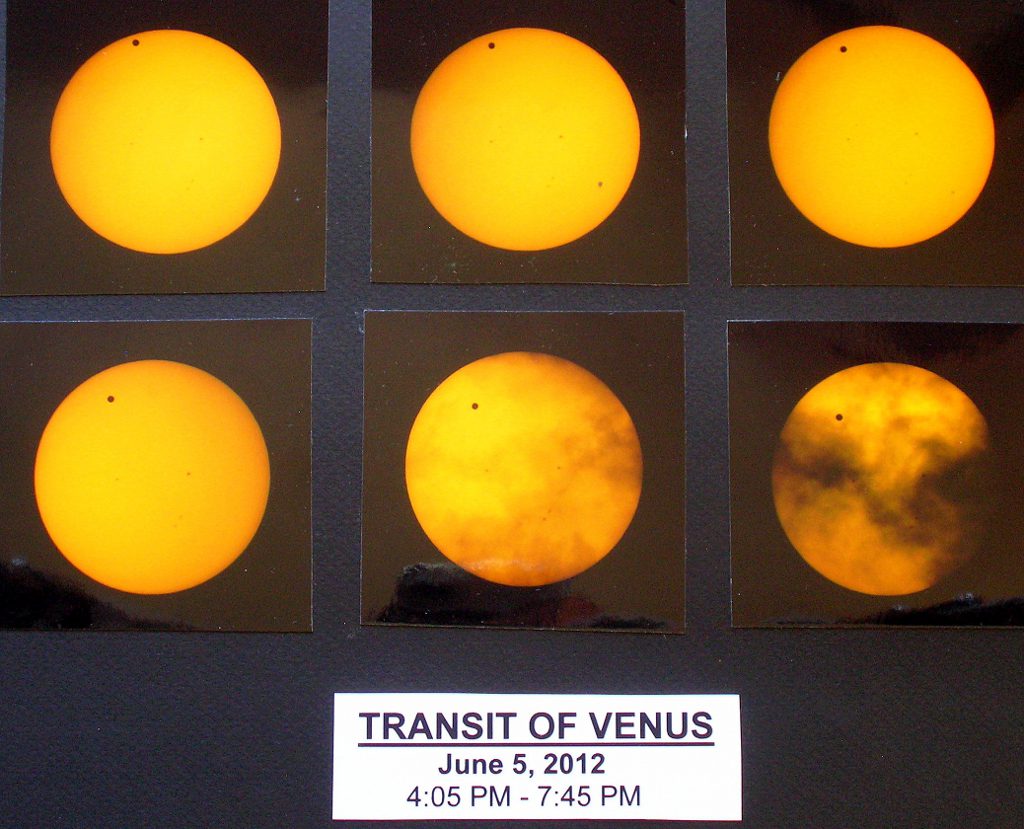 |
|
Richard
Bohner captured this from his home in Cottonwood.
Photo:
Richard Bohner |
The clouds
moved in for this montage from Wyoming. Taken thru an Orion
102mm Mak with a Kendrick solar filter and a dark yellow
eyepiece filter. A Nikon point and shoot camera was used.
Photo: Pat
Seals |
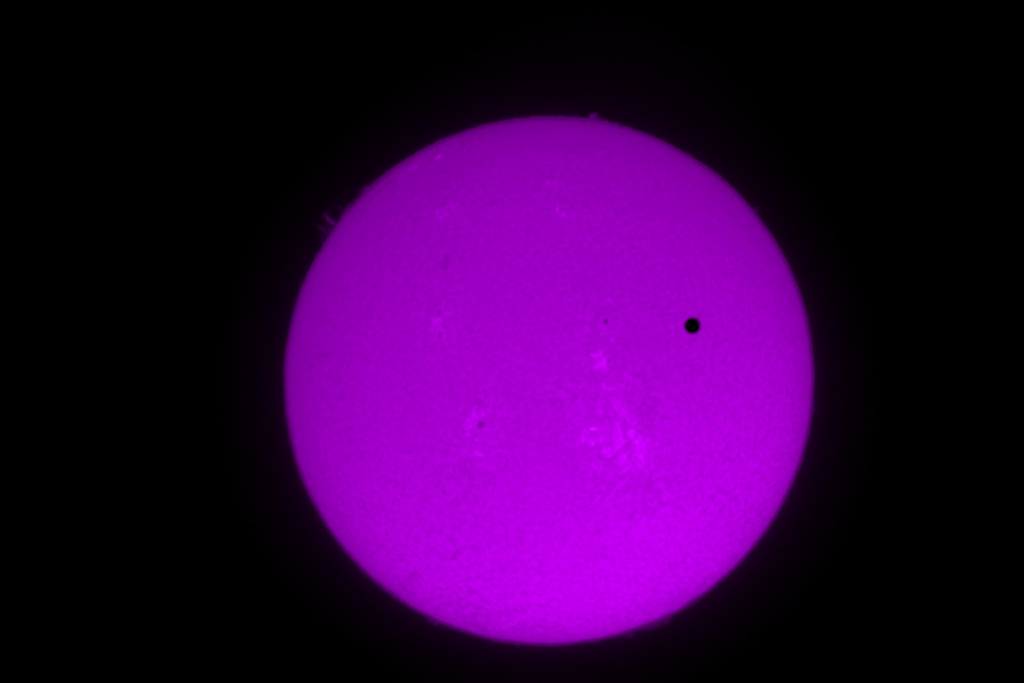 |
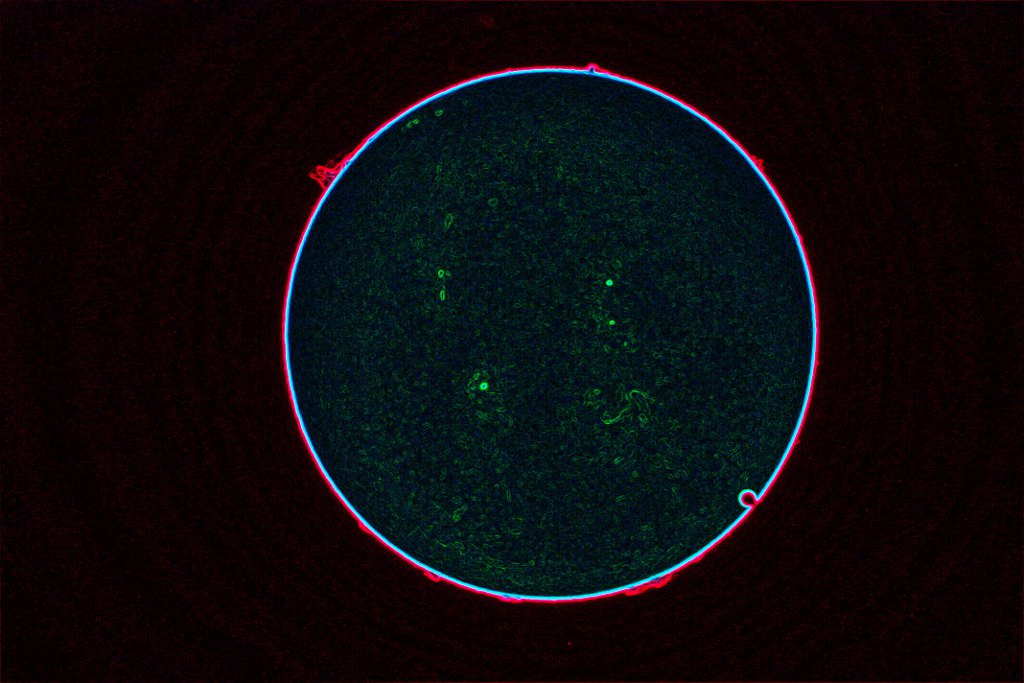 |
|
As with the
solar eclipse, viewers were able to watch the transit with a PST
CaK telescope that sees the Sun's surface in the ultraviolet
spectrum.
Photo: J D
Maddy |
Using edge
detect software, the flares and prominences stand out as well as
Venus' second contact.
Photo: J D
Maddy |
|
|
|
|
|
|
 |
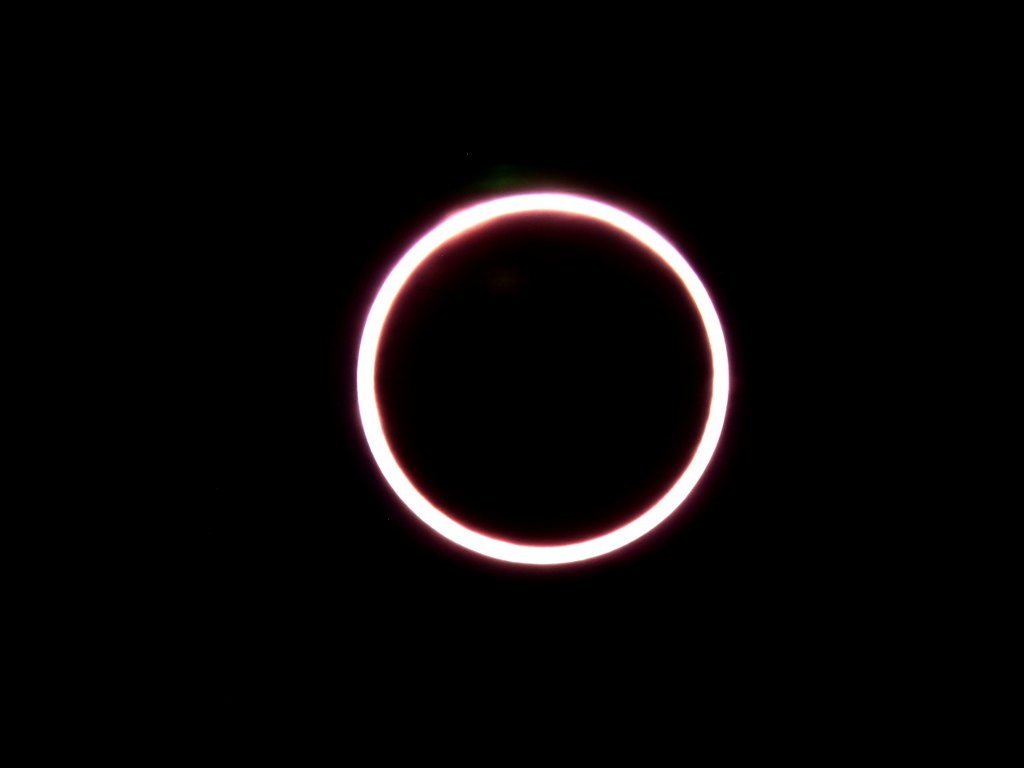 |
|
Pat traveled to Cedar City, UT
to capture this eclipse picture.
Photo: Pat Seals |
Cedar city
was in the center path of the eclipse as evidenced by this
picture.
Photo: Pat
Seals |
 |
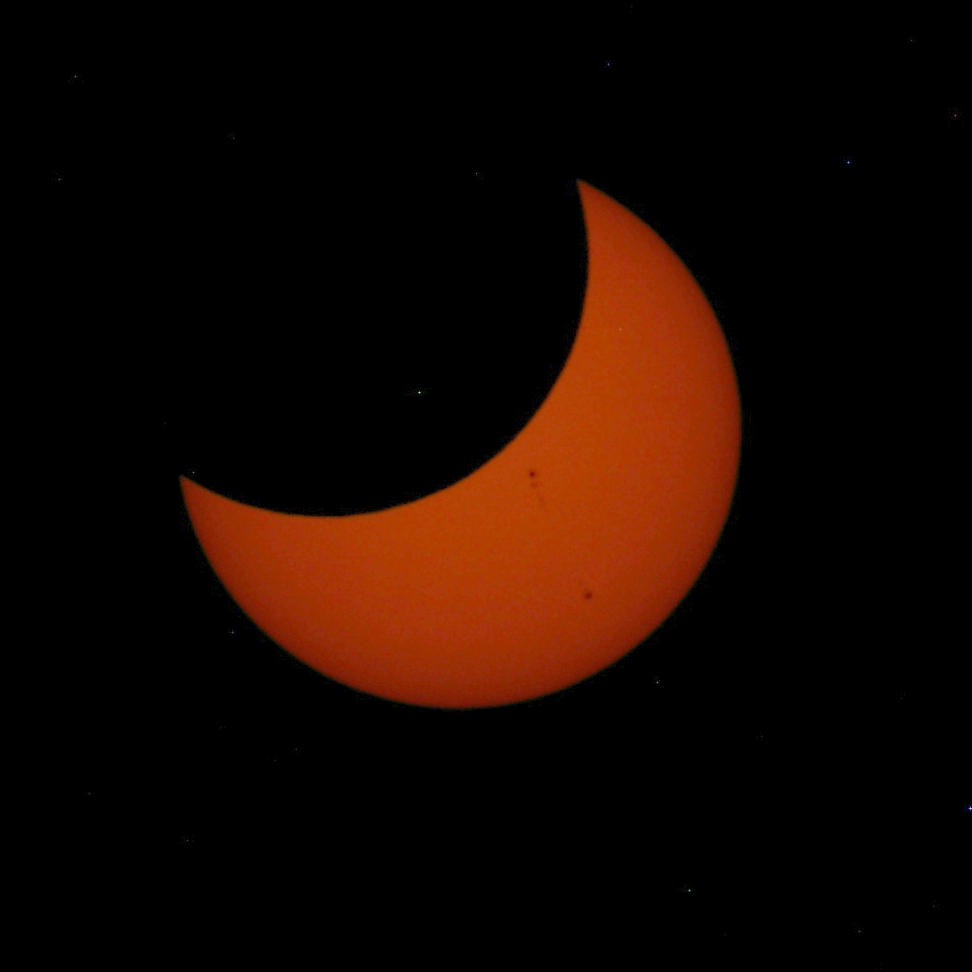 |
|
The Moon is
ready to gobble up a large Sun spot.
Photo: J D
Maddy |
The Moon has
uncovered the Sun spot on the right.
Photo: J D
Maddy |
 |
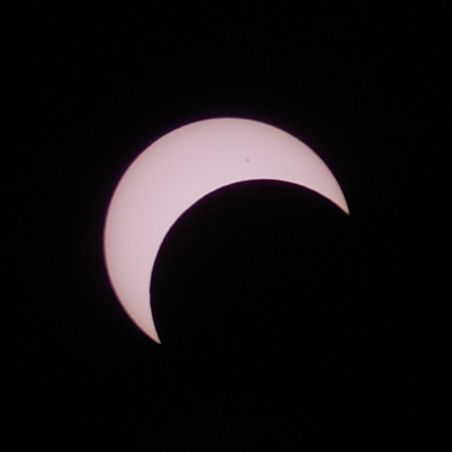 |
|
First
Contact using Baader ND 5 solar film.
Photo: Tim
Haggerty |
On the way
to annular eclipse using Baader ND 5 solar film.
Photo: Tim
Haggerty |
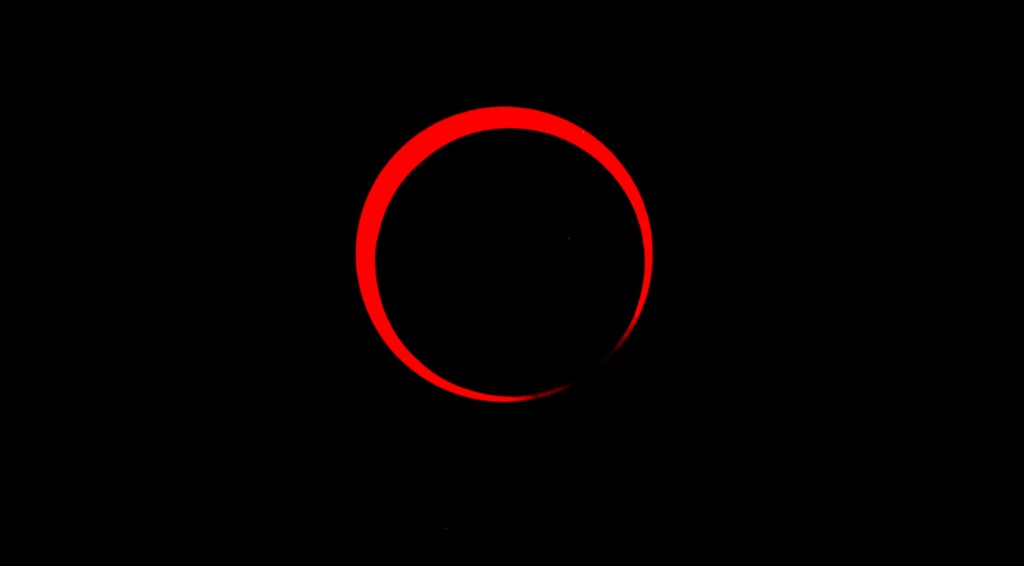 |
 |
|
Doug
Ostroski sees second contact from the Page, AZ site.
Photo: Doug
Ostroski |
Annularity
occurs at Page, AZ.
Photo: Doug
Ostroski |
 |
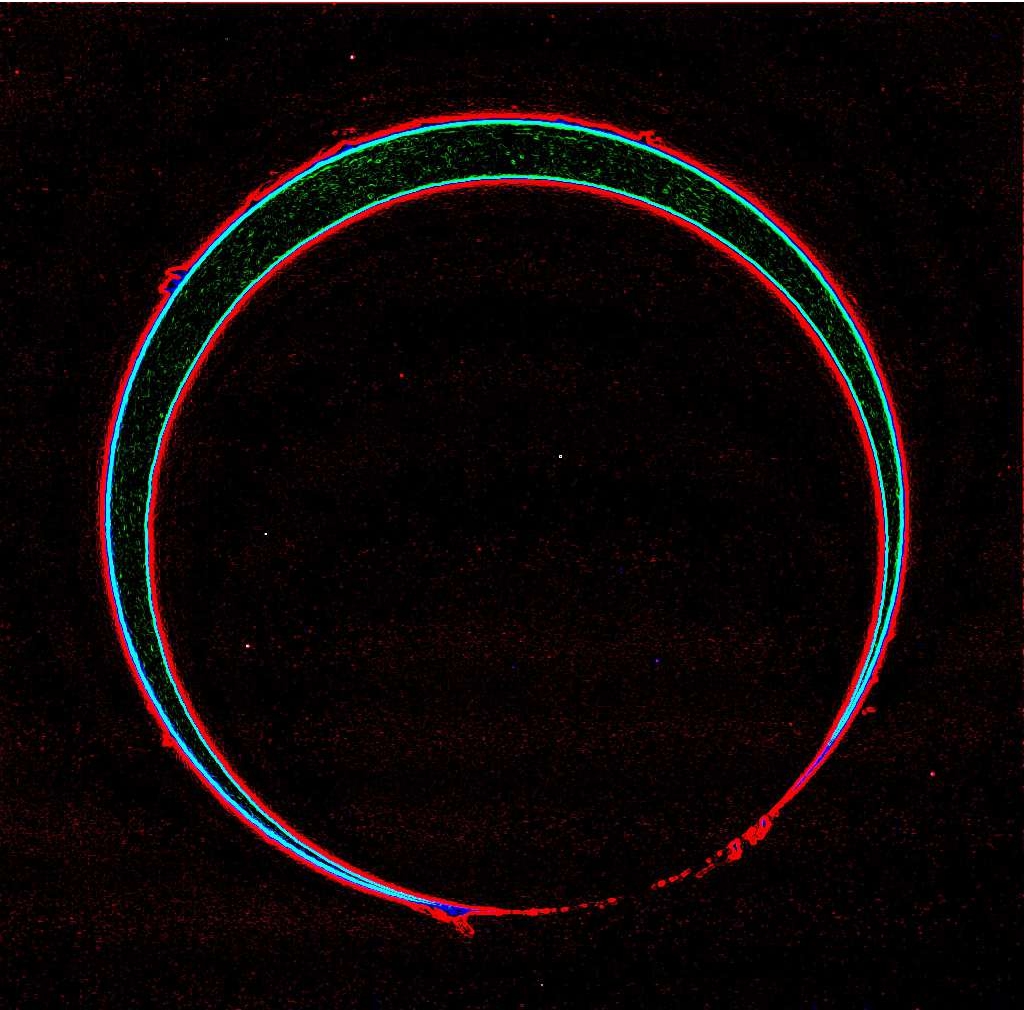 |
|
An eclipse
picture may not be unique. But, an eclipse picture with an
aircraft crossing is a once in a life time shot. Large Sun spots
also dot the surface.
Photo: Ted
Cooke |
Using edge
detecting software, the flares and promineneces come to life at
second contact. |
|
|
|
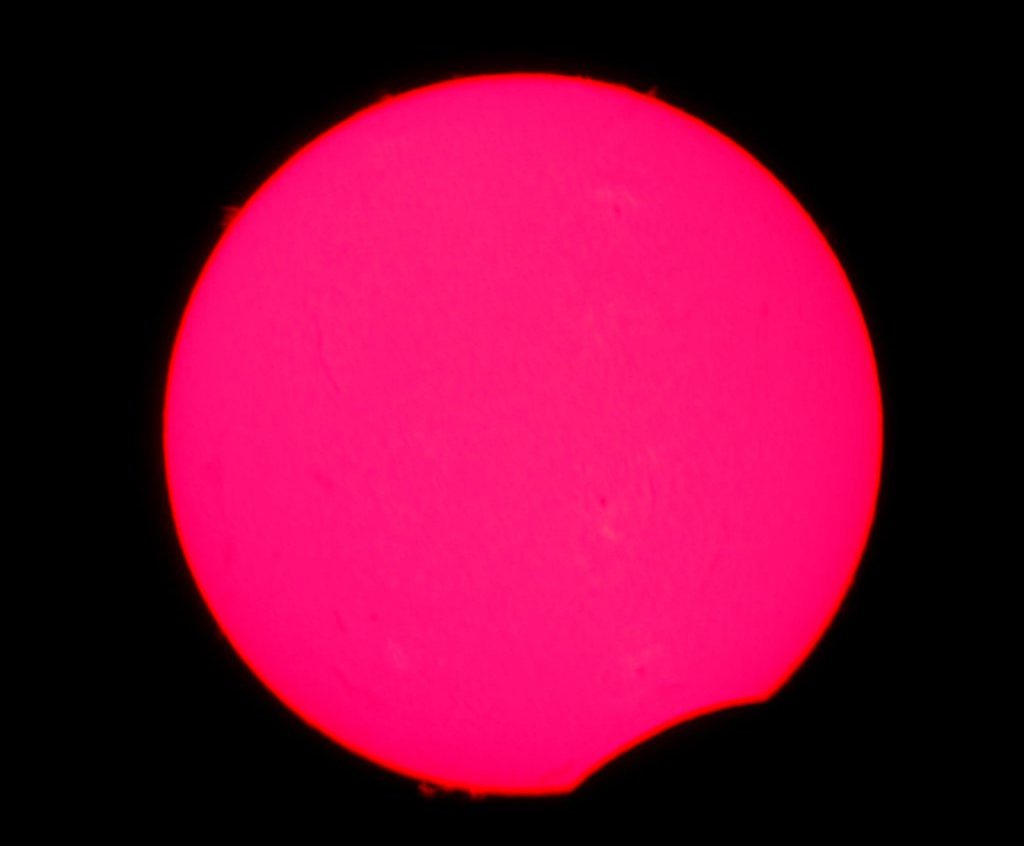 |
 |
|
|
|
|
First
contact taken with a 60mm Lunt Hydrogen Alpha telescope.
Photo: J D
Maddy |
Hydrogen
alpha (Ha) telescopes allow the viewer to see solar flares and
prominences at the edge of the Sun.
Photo: J D
Maddy |
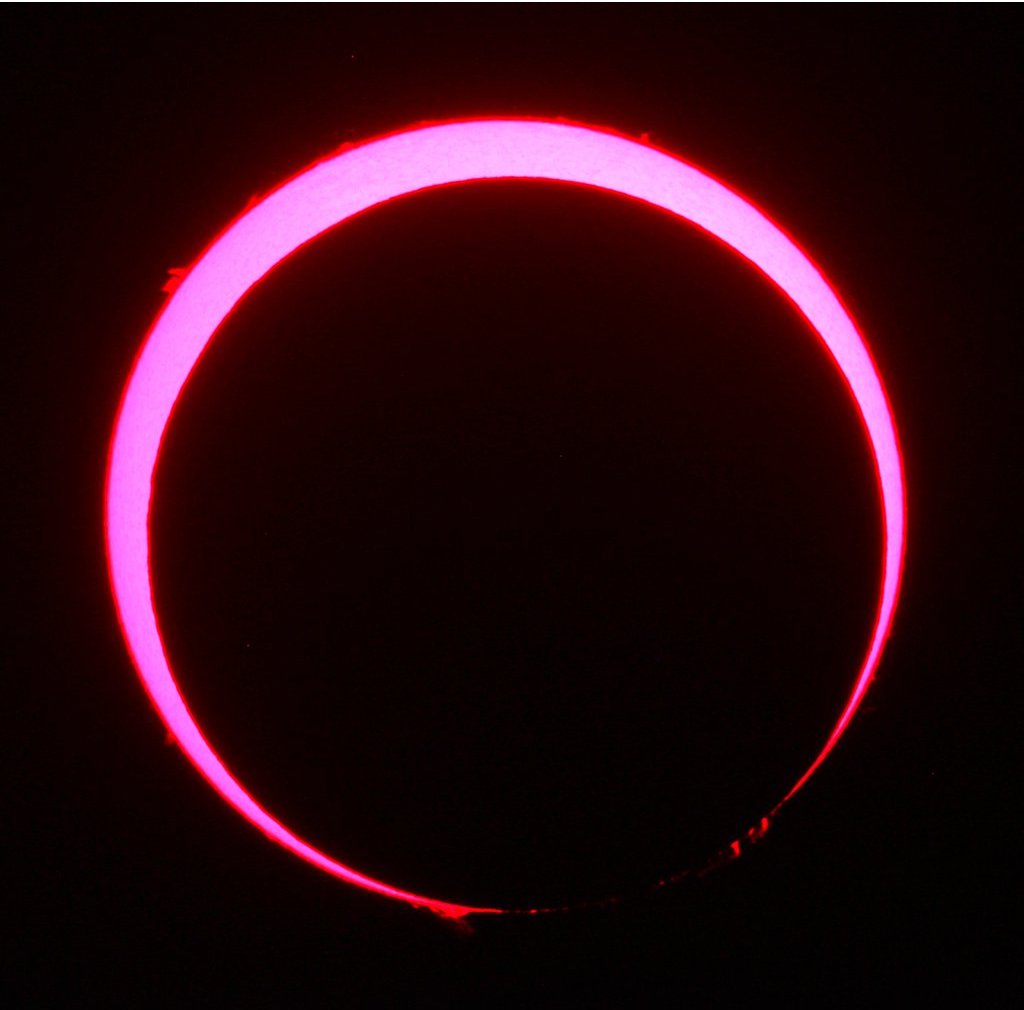 |
 |
|
Second
contact occurs when the trailing edge of the Moon touches the
edge of the Sun.
Photo: J D
Maddy |
Third
contact occurs when the leading edge of the Moon touches the
edge of the Sun as it is departing the eclipse.
Photo: J D
Maddy |
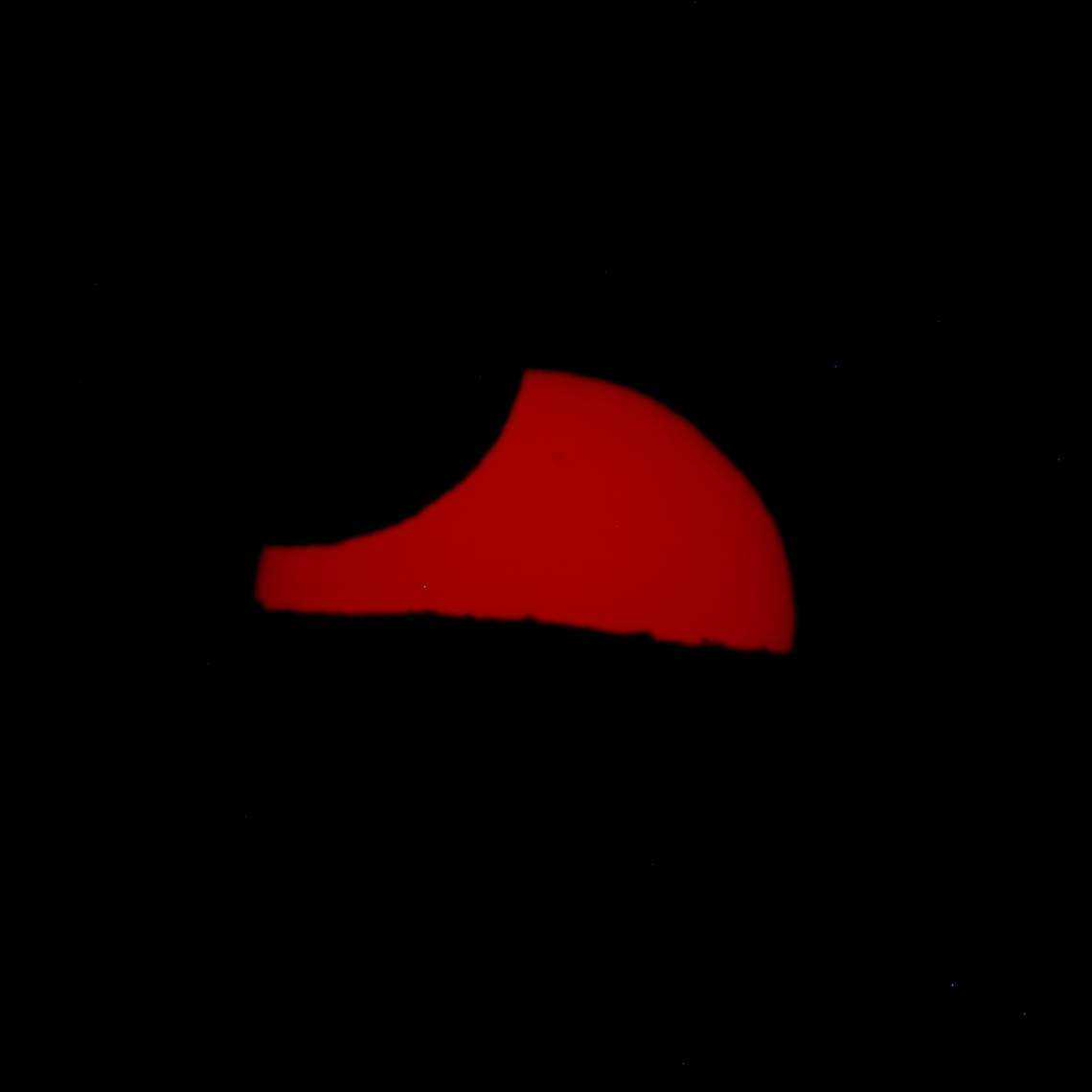 |
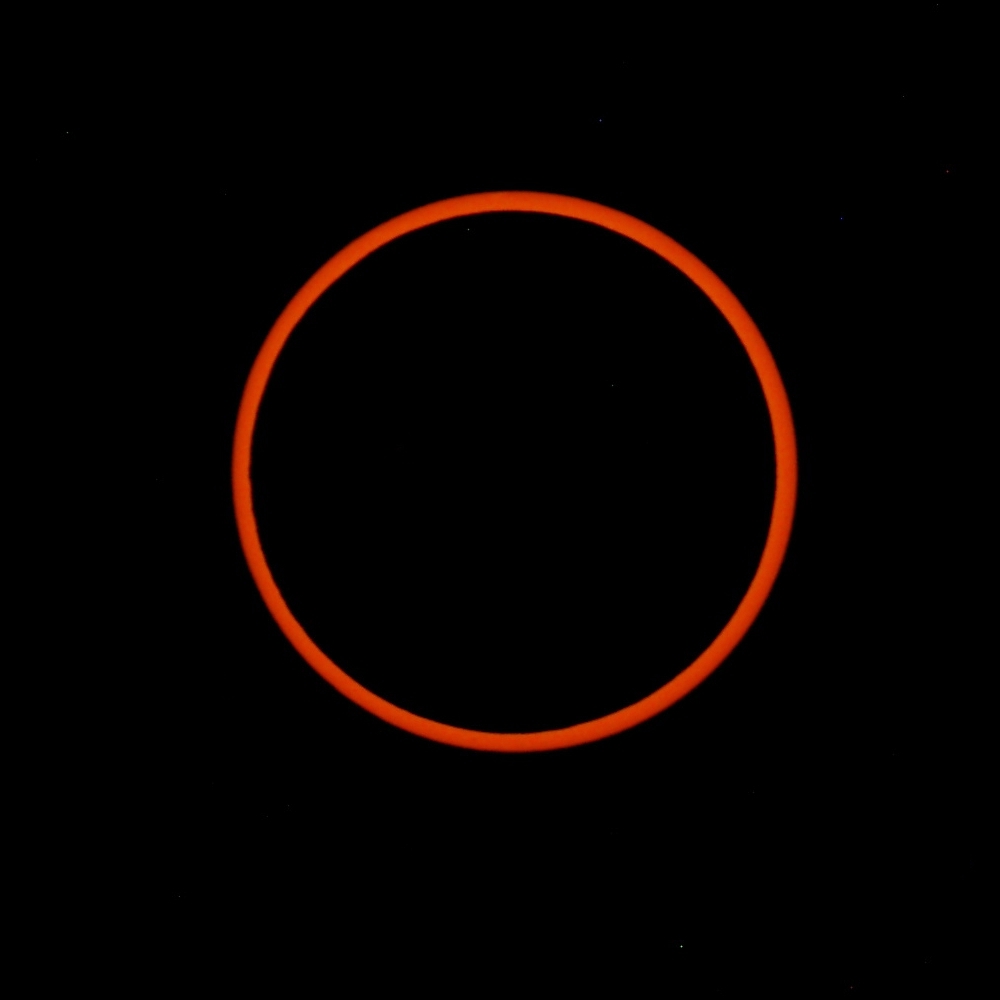 |
|
Fourth
contact was not visible from Lone Rock as the Sun and Moon set
before the event occurred.
Photo: J D
Maddy |
Annularity
occurs as the Moon is centered as it travels in front of the
Sun. As you can see, Lone Rock was in the path's center.
Photo: J D
Maddy |
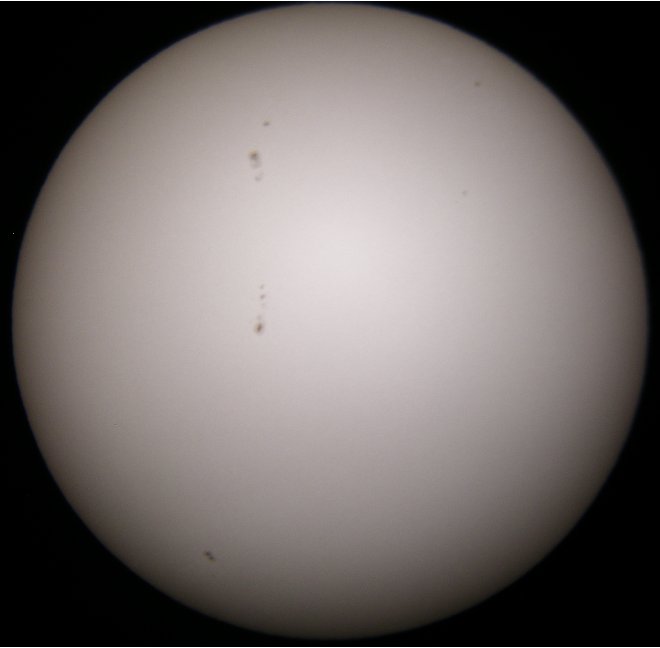 |
 |
|
Karen Maddy
gets into eclipse mode as she snapped this with her Point and
Shoot before the eclipse thru the eyepiece of her 6"
Pierre Schwar.
Photo: Karen
Maddy |
Karen shoots
another photo with her Point and Shoot thru her polarized
sunglasses. Never look at the Sun directly during an annular
eclipse as the Sun can still be 10,000 times brighter than a
full Moon. Edited to show the "ring of fire" seen with eclipses.
Photo: Karen
Maddy |
 |
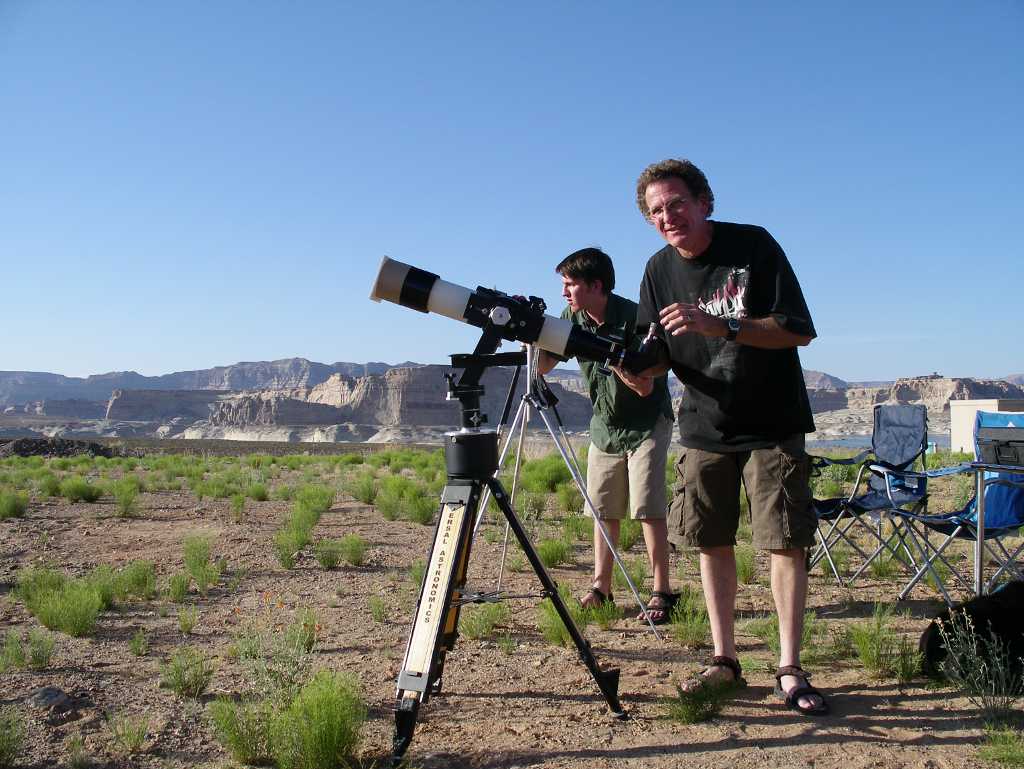 |
|
Club member
Dennis Casper shows how to make and use a pin hole device to
safely view the eclipse.
Photo: Karen
Maddy |
Club members
Ted and Payton Cooke view and take pictures of the eclipse.
Hopefully, Ted took the unique picture of a
plane going across the Sun as the eclipse occurred. (See above)
Photo: Karen
Maddy |
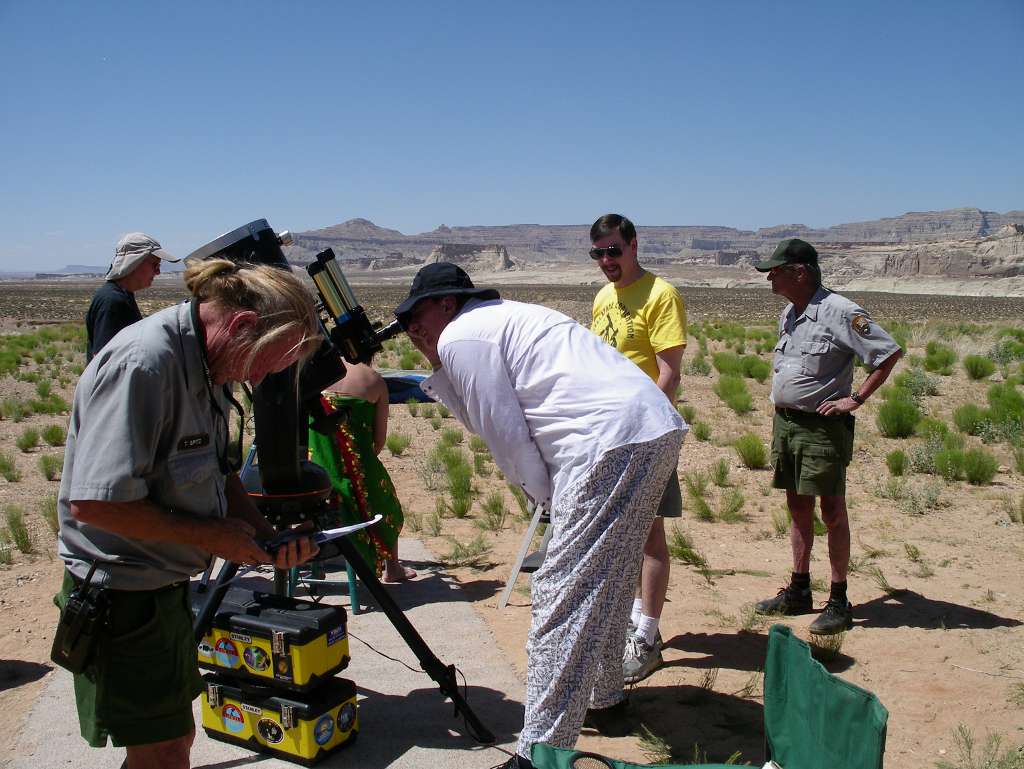 |
 |
|
SAC member
Bob Christ takes a look thru an Ha telescope as the eclipse
enters annularity. The temperature dropped 15 degrees as the Sun
was mostly covered by the Moon.
Photo:
Karen Maddy |
Astronomer
and author Jeff Dershem from Grand Junction, CO uses a small
telescope to project the eclipse onto a piece of paper. His
latest book "Planets to Pulsars: A Citizen's Guide To the
Universe" is now available. It's a great book for novices as
well as experienced amateurs.
Photo: Karen
Maddy |
 |
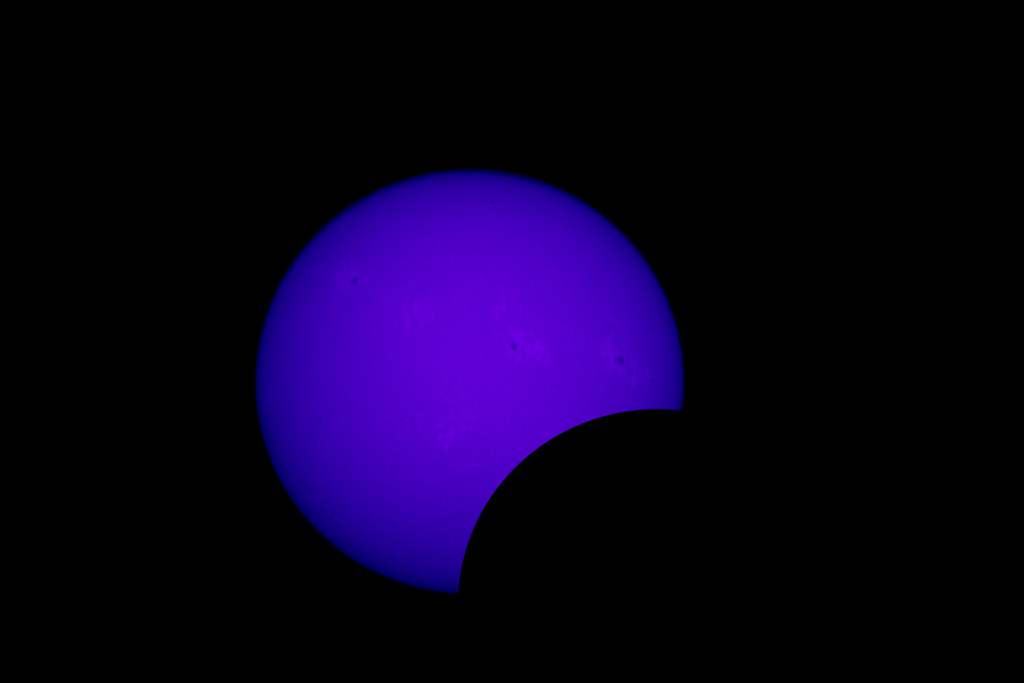 |
|
The eclipse
viewers had not only a look at the Sun in visual and hydrogen
alpha wavelengths, but also calcium-potassium wavelengths. This
produces an image in the blue and ultraviolet. This type of
telescope shows different features on the surface of the Sun.
Photo:
J D Maddy |
Although the
CaK telescope was used for visually seeing the eclipse, here's a
representation of what they saw in the telescope's eyepiece.
Photo: J D
Maddy |
 |
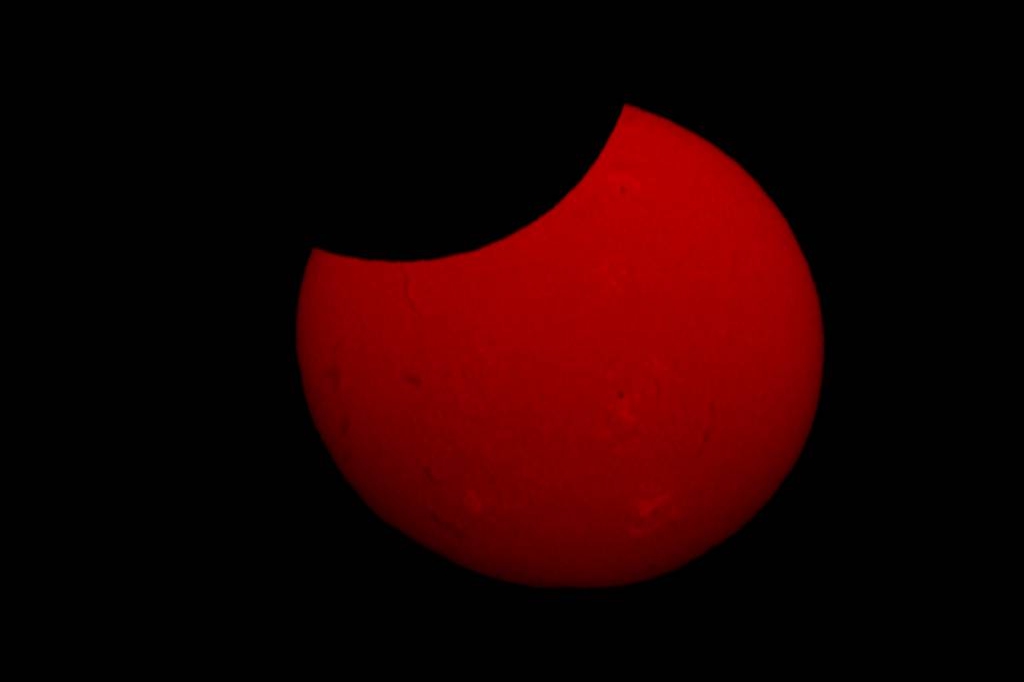 |
|
As the Sun
neared the horizon, the flares disappeared and the surface
detail became more evident.
Photo: J D
Maddy |
As the Sun
neared the horizon, the flares disappeared and the surface
detail became more evident.
Photo: J D
Maddy |
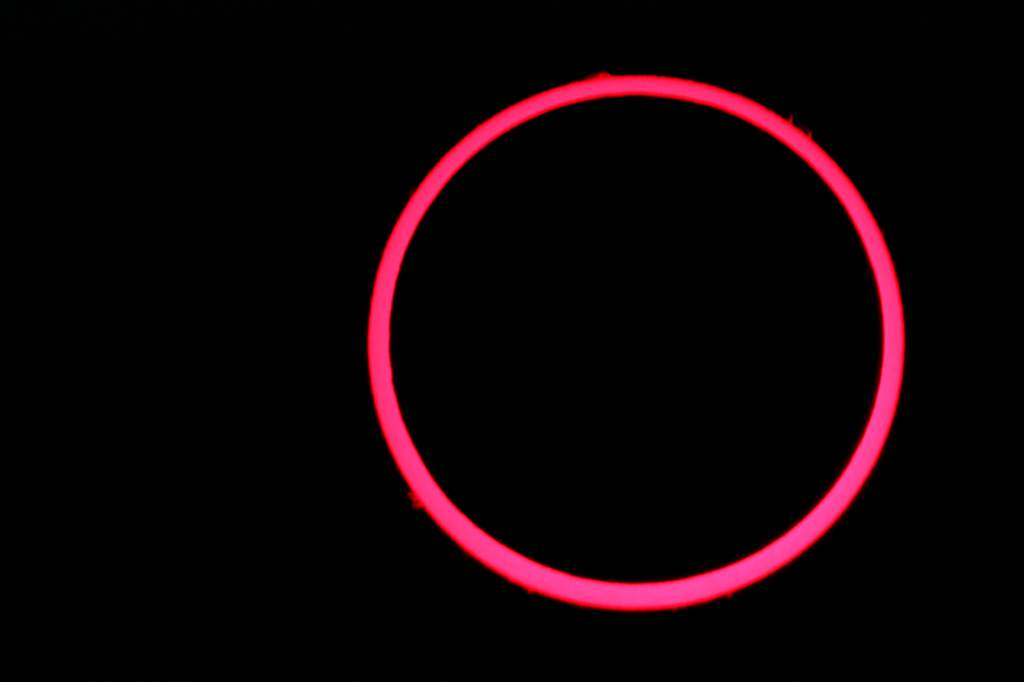 |
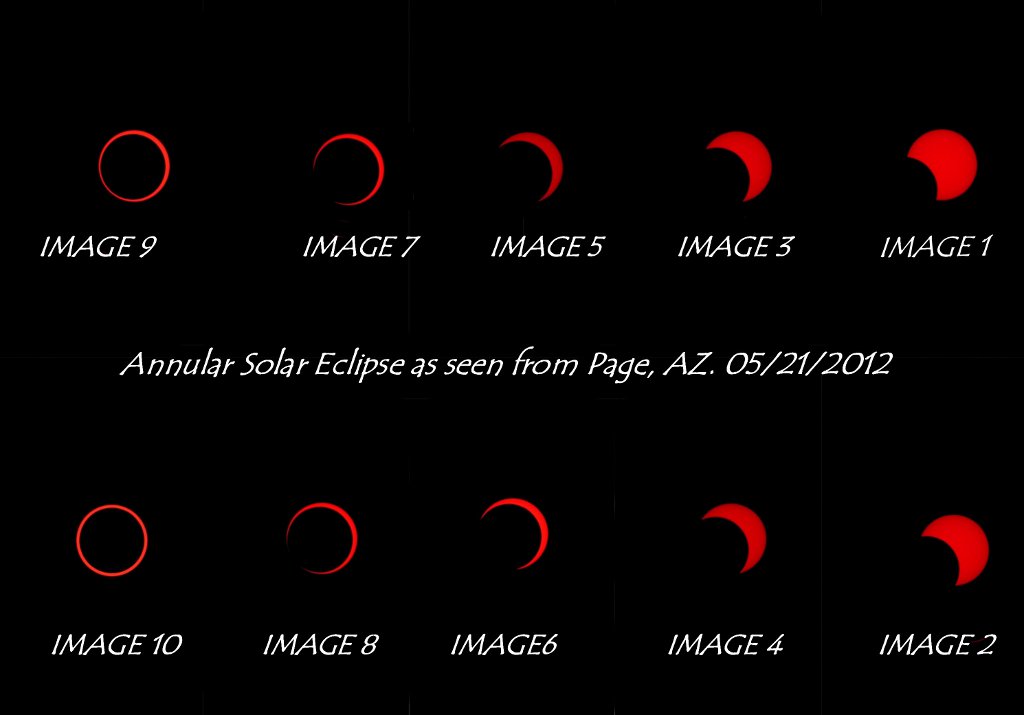 |
|
As the Sun
became annular, small flares could be seen along the edge of the
Sun.
Photo: J D
Maddy |
A photo
montage from Doug Ostroski. Click the picture for a full screen
view.
Photo: Doug
Ostroski |
 |
 |
|
What if we
lived in a multi-sun solar system and the eclipsed sun was a dim
white dwarf? This might be what we would see.
Photo
Editing: J D Maddy |
Nearing
second contact using Baader solar film.
Photo: Tim
Haggerty |
 |
 |
|
Some surface
detail can be see during the eclipse with an Ha telescope.
Photo: J D
Maddy |
A unique
phenomenon that occurred with the eclipse was the Sun's size at
it neared the horizon. It appeared to shrink in diameter. The
picture on the left was taken at 5:27PM. The picture on the
right was taken at 7:19PM.
Photo
Montage: J D Maddy |
 |
 |
|
Photo
montage by J D Maddy |
Photo
montage by Tim Haggerty |
 |
|
|
Another montage
from Club Member Doug Ostroski. |
|